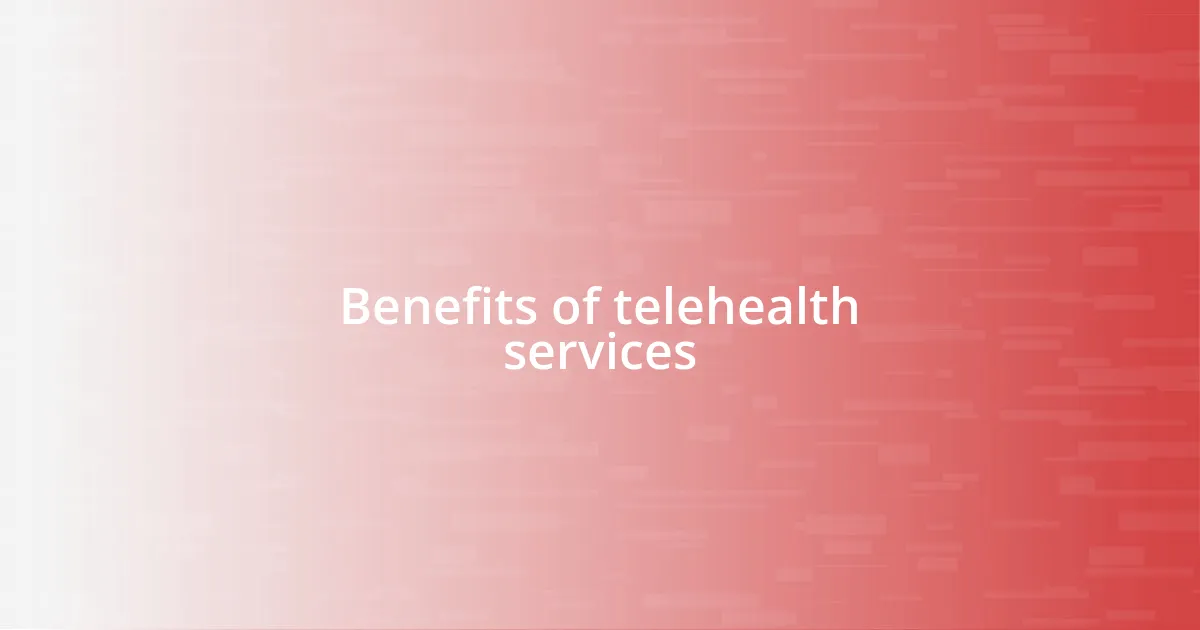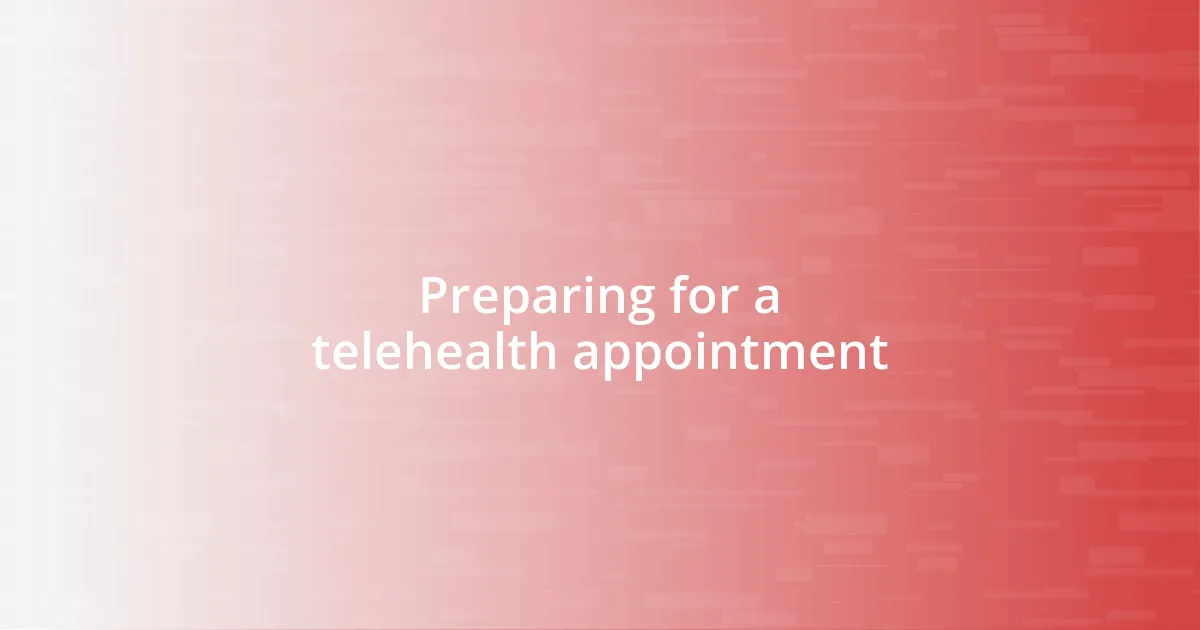Key takeaways:
- Telehealth consultations enhance convenience and accessibility, allowing patients to receive care without geographical and time barriers.
- Choosing the right telehealth platform improves the user experience; key factors include user-friendliness, security, and customer support.
- Effective preparation for appointments, including creating a distraction-free environment and gathering medical information, can lead to more productive consultations.
- Future advancements in telehealth may include AI integration, hybrid care models, and wearable health technology for improved patient monitoring and personalized care.

Understanding telehealth consultations
Telehealth consultations have transformed the way we approach healthcare by leveraging technology to connect patients with providers remotely. I remember my first experience with a virtual appointment; sitting in my living room, I felt a mix of excitement and nervousness. Could a screen really replace the warmth of an in-person visit? But as the consultation unfolded, I was surprised to find the experience surprisingly seamless.
One of the key aspects of telehealth is its ability to break down barriers, such as geography and time constraints. I once had a follow-up appointment scheduled at a time that would have required a two-hour commute. Instead, I joined from my office during lunch, allowing me to access quality medical advice without the stress of travel. How many missed opportunities for care might we avoid by embracing this flexible approach?
On a deeper level, telehealth fosters a sense of empowerment among patients. I’ve personally felt more confident discussing my health concerns in a familiar setting, where I could focus and share freely without the anxiety of a waiting room. Isn’t it fascinating how our environment can impact our willingness to communicate openly about our health? The digital platform didn’t just provide convenience; it allowed for a richer conversation about my well-being.

Benefits of telehealth services
One of the most significant benefits of telehealth services is convenience. I remember a day when I had a lingering cough, and the thought of sitting in a crowded waiting room made me groan. Instead, I booked a telehealth appointment and, within minutes, I was speaking to my doctor from the comfort of my couch. It really hit me then how easy technology can make healthcare access.
Cost-effectiveness is another advantage that stood out during my experiences. My telehealth consultations were often less expensive than traditional in-person visits, which surprised me. I recall one consultation where I saved not only on the appointment fee but also on gas and parking, which typically adds up. It seems like a no-brainer; why wouldn’t more people take advantage of this kind of healthcare option?
Beyond just saving time and money, telehealth can lead to more frequent check-ins with healthcare providers. By using an app, I could schedule follow-up appointments without the hassle of reworking my entire calendar. This frequency has made me more proactive about my health. Have you ever thought about how consistent communication could enhance your understanding of your health conditions? For me, it truly has.
| Benefit | Description |
|---|---|
| Convenience | Ability to attend appointments from home, reducing time and stress. |
| Cost-Effectiveness | Generally lower fees compared to in-person visits, saving money on travel and clinic costs. |
| Increased Frequency of Check-Ins | Enables more regular interactions with healthcare providers, fostering proactive health management. |

Choosing the right telehealth platform
Choosing the right telehealth platform can significantly impact your experience, making it crucial to evaluate your options carefully. When I was searching for a platform, I found that accessibility was a top priority. The user interface can vary greatly; I once chose a platform that felt overwhelming and confusing, which added unnecessary stress to an already tense situation. Finding a solution that is intuitive not only enhances the experience but also ensures that you can access the care you need without added frustration.
Here are some key factors to consider when selecting a telehealth platform:
- User-Friendliness: Opt for a platform that is easy to navigate, even for those who may not be tech-savvy. I appreciated the one I chose; it felt like having a helping hand guiding me through the process.
- Security Features: With personal health information involved, choose a platform that prioritizes privacy and data security. I learned the hard way that it’s crucial; my comfort with sharing sensitive information relied heavily on this.
- Integration with Existing Records: I preferred platforms that sync with my healthcare provider’s systems. It made consultations quicker and ensured that all my medical history was readily available, which can be a real time-saver.
- Technical Support: Look for platforms that offer robust customer service. Once, I encountered technical issues right before a scheduled appointment, and having access to immediate support made all the difference in my experience.
- Insurance Compatibility: Double-check if your insurance plan covers the platform. I was caught off guard with a consultation that wasn’t under my plan, so knowing these details upfront is key.
Ultimately, finding the right telehealth platform can transform a potentially stressful experience into something smooth and manageable.

Preparing for a telehealth appointment
When preparing for a telehealth appointment, I’ve learned that creating the right environment can make a significant difference. The first time I dialed in, I sat on my bed, surrounded by distractions, and found it hard to focus. Now, I ensure that I choose a quiet spot with good lighting where I can comfortably discuss my health without interruptions. Have you thought about how your surroundings affect your concentration during a virtual visit? It really struck me how much a tidy, peaceful space can enhance the conversation.
Another essential tip is to gather your medical information ahead of time. I remember a situation where I forgot to have my medication list ready, which left me scrambling mid-appointment. By taking a few minutes to note any symptoms and questions beforehand, I’ve made the process smoother both for myself and my healthcare provider. Plus, having everything at my fingertips allows for a more structured dialogue that ultimately leads to better care. It felt empowering to take control of my health like this.
Lastly, testing your technology before the appointment is crucial. The first time I had to troubleshoot my audio settings just as the doctor joined was a nerve-wracking experience! I now make it a habit to perform a quick check on my device’s camera and microphone to avoid any hiccups. This simple step helps me relax and focus on the consultation rather than fixing tech issues. Have you ever found yourself caught up in these last-minute technical snafus? It’s a common struggle, but a quick test can save you a lot of stress.

Tips for effective communication
Effective communication is key during telehealth consultations, and one tip I find invaluable is to speak clearly and at a moderate pace. In my early experiences, I rushed through my concerns, which left both me and the healthcare provider frustrated. Since then, I’ve made it a point to slow down and articulate my thoughts. Have you ever felt misunderstood during a conversation? I realized that when I took my time, it created a clearer dialogue that benefited both sides.
Another crucial aspect is active listening. I remember a time when my doctor was explaining a treatment plan, and I was so focused on my own thoughts that I missed some important details. Now, I make it a habit to summarize what the provider says and ask clarifying questions if needed. This not only shows my engagement but also ensures that I truly comprehend the advice being given. Have you ever nodded in agreement only to forget what was said moments later? That experience taught me how vital it is to be present in those conversations.
Lastly, non-verbal communication plays a significant role, even in a virtual setting. I learned to maintain eye contact by looking at the camera rather than the screen, which creates a sense of connection. It may feel a bit odd at first, but I’ve noticed that it encourages more meaningful exchanges. How does it feel to connect with someone who’s truly focused on you? For me, shifting my gaze to the camera transformed my consultations from a flat experience into a more personal interaction, enriching my overall telehealth journey.

Common challenges in telehealth
One common challenge I often faced in telehealth was the difficulty in establishing rapport with my healthcare provider. I remember a session where I felt disconnected, as if my doctor was just a voice on the other end of the line. It’s amazing how much body language and presence contribute to feeling understood. Have you ever noticed that spark of connection fade when you’re not physically in the same room? It made me realize that although tech has its perks, it can dampen the personal touch that fosters trust.
Another hurdle I encountered was the variance in my internet connection. I can’t count how many times my call dropped or froze mid-conversation, leading to frustrating pauses. Those moments opened my eyes to the technical barriers of telehealth. Have you ever been in the middle of sharing something important only for the feed to lag? Addressing these issues often left me feeling anxious about future appointments. It taught me the necessity of a reliable setup to ensure my health discussions flow smoothly.
Moreover, one challenge I didn’t anticipate was the complexity of following up on care plans. After a consultation, I’d sometimes forget or struggle to recall the specific instructions. It was disheartening to feel uncertain about the next steps in managing my health. Have you had that nagging feeling of doubt after leaving an appointment? I started recording notes during consultations and making a playlist of follow-up tasks to keep everything organized, turning this challenge into a structured routine that has improved my healthcare management immensely.

Future of telehealth consultations
I see a promising future for telehealth consultations, especially as technology continues to evolve. With advancements in artificial intelligence, we might soon experience virtual consultations that feel even more personalized. For instance, I can envision a scenario where AI assists in gathering my medical history and preferences before I ever connect with a healthcare provider. Wouldn’t it be amazing if it could anticipate my concerns based on past interactions? That potential excites me!
As more people embrace telehealth, I believe we’ll also see an increase in hybrid models of care, blending in-person and virtual visits. I recall a time when my doctor offered me a follow-up video call instead of requiring another trip to the office; it saved me so much time and hassle. Imagine what it would be like if we had dedicated telehealth platforms that provided seamless access to specialists across the globe, making quality healthcare available to anyone, anywhere. What possibility does that open up for you?
Finally, I am genuinely hopeful about the potential integration of wearable health technology with telehealth. During a recent consultation, I was thrilled when my doctor accessed my fitness tracker data in real-time. This helped her give tailored advice based on my actual activity levels. How great would it be to have continuous health monitoring, allowing healthcare providers to make decisions based on up-to-date information? This connection between wearables and telehealth could truly revolutionize our approach to health and wellness in the future.















